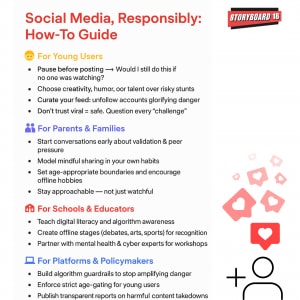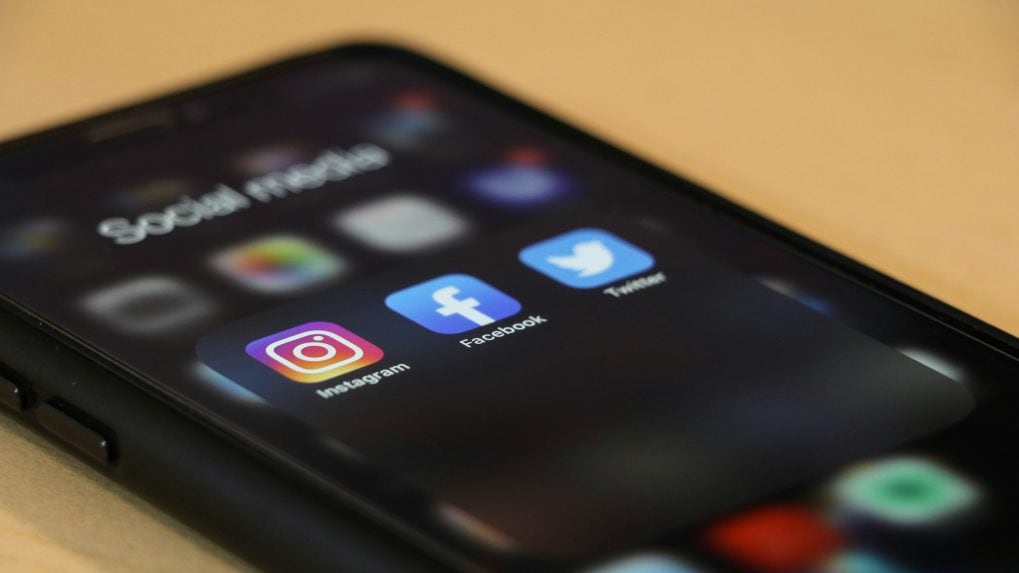#SocialMediaResponsibly: Parent-School partnership: Confronting the exploitation of teen social media users
Social media companies are exceptionally aware of how their product lands on developing brains and use this to exploit teens to sell their products, according to experts.
ADVERTISEMENT
Note to readers:
In an always-on world, the way we use social media shapes not just our lives but the safety and wellbeing of those around us. 'Social Media, Responsibly' is our commitment to raising awareness about the risks of online recklessness, from dangerous viral trends to the unseen mental and behavioural impacts on young people. Through stories, conversations and expert insights, we aim to empower individuals to think before they post, to pause before they share, and to remember that no moment of online validation is worth risking safety. But the responsibility does not lie with individuals alone. Social media platforms must also be accountable for the environments they create, ensuring their tools and algorithms prioritise user safety over virality and profit. It’s time to build a culture where being social means being responsible - together.
In an era where children are as fluent in Instagram reels and TikTok trends as they are in textbooks, the question of social media responsibility looms large. Educators are increasingly being called on not only to teach math and science, but also to equip students with the resilience and judgment to navigate online spaces safely.
The Double-Edged Sword of Digital Creativity
“Social media is so much embedded in the life of youth, providing the potential for communication, creativity, and self-expression. But it also brings with it contact with trends and behaviors that are full of safety risks,” said Niru Agarwal, Managing Trustee, Greenwood High International School.
Agarwal stressed that in the pursuit of online validation, young people can make rash decisions without fully understanding the consequences. “There is a need to establish an educational environment that nurtures awareness and critical thinking in this regard. Encouraging students’ understanding that their own safety and welfare always need to come before temporary online fame is central to the formation of good digital citizens.”
For Greenwood High, the approach combines values and vigilance. “All families, schools, and communities share responsibility for promoting open, continuous conversation about children's exposure to media, influences to which they are exposed, and their own decision-making,” Agarwal explained. Programs emphasize resisting peer pressure, valuing responsibility and self-awareness, and affirming respect for self and others.
The Exploitative Nature of Social Media
“Eight years ago when I was hired for this role, the Board of Directors was very concerned about an online phenomenon called ‘blue whale.’ If you remember, blue whale led teens down a rabbit hole that ultimately ended in their being asked to commit suicide; many did. The destructive influence of social media is absolutely real and companies absolutely bear responsibility for what is on their platforms,” said Dr. Ted Mockrish, Head of School, Canadian International School, Bangalore.
Mockrish underscores that social media companies know exactly what they’re doing. “Worldwide, we are fighting a multi-billion dollar industry that is exploiting the natural risk-taking behaviors of teens for their own gain. Social media actively exploits teens for profit. They are in the business of harvesting emotions and personal choices to use and sell as information. Social media companies are exceptionally aware of how their product lands on developing brains and use this to exploit teens to sell their product.”
He adds that while banning social media is not the answer, parents, schools, and policymakers need to confront the issue collectively. “Time in open dialogue with students, parents, caregivers, educators is absolutely needed. But political backbone is also needed, and unfortunately, social media companies have very big purses with which to influence policy, or the lack thereof.”
Creating a ‘Responsible Bubble’
At Finland International School, responsibility is a proactive strategy rather than a reactive response. “A close-knit community, we work on preventive strategies and therefore can say we have not seen a rise,” said Fatema Agarkar, Educationist and Advisor. “Perhaps this ‘responsible bubble’ consciously nurtured and developed, where students are exposed to ‘cause and effect’ scenarios, case studies and strategic discussions to help them model responsible behaviour will continue to be work-in-progress, for we all know that trends change.”
This bubble is reinforced not just by teachers, but also by peers. “This is not an era where students will just follow dictates. Through communication, reminders, and conversations with parents and teachers, we are able to create a ‘responsible bubble’ that protects the innocence of children. A large part of that is peer learning — our student council seniors speak to the younger ones, because that positive peer influence often prevents mistakes more effectively than adults simply sharing their perspectives.”
Preventive Tools and Protocols
Agarkar highlights the combination of human vigilance and technical safeguards. “We have protocols and firewalls in place, we have Digital Literacy policies communicated through our handbooks and plenty of discussions during the week, week on week, and essential agreements that are checked. We also work with Switch for Schools, which helps us understand a child’s well-being and mental status and gives us a ‘heads-up’ that can help us monitor some tendencies and provide preventive strategies. This enables us to step in early if we feel a child is getting influenced by a trend.”
Read More:#SocialMediaResponsibly: The new peer pressure - Why "How many views?" is replacing "How are you?"
Mockrish agrees that schools cannot work in isolation. “Parent education is a critical piece to supporting any movement to limit the negative and harmful effects of social media on teens, and even adults. As a school, parents secretly thank us for banning cell phones on campus and social media, but may not follow through at home for fear of causing a fight. This is a 360-degree effort and we want and welcome parents as partners to understand that ‘just saying no’ is as ridiculous a strategy as 100% permission to use social media.”
Balancing Creativity with Responsibility
At the heart of these approaches lies a recognition that creativity itself is not the problem — but it must be balanced with responsibility. “There has to be creativity. When we talk about research, the whole idea is to find a reliable and validated source that leads to inquiry. But it comes with a double-edged sword — we must balance creativity, individuality, and perspective with responsibility,” said Agarkar.
To that end, Finland International School deploys inquiry-based curricula that encourage mindfulness and awareness. Guest speakers, group discussions, and case studies are frequently used, sometimes even involving influencers who share stories of when digital trends went wrong.
Yet, Agarkar admitted, there is no foolproof formula. “It is tricky to find that ‘perfect balance’ but because we hold this as a priority of wellbeing as part of our vision, it is constantly reviewed and we upgrade our own strategies from time to time, in a hope that we can ‘prevent.’ It’s not a perfect science and that is why communication is the key.”

What You Can Do: Practical Steps for Safer Social Media
For Young Users
Pause before posting: Ask yourself—would I still do this if nobody was watching?
Choose safer ways to stand out: Showcase creativity, humor, or talent instead of risky stunts.
Curate your feed: Follow accounts that inspire, educate, or entertain positively. Unfollow or mute pages that glorify dangerous trends.
Check the source: If a challenge looks risky, it probably is. Don’t trust trends just because they’re viral.
For Parents and Families
Open conversations early: Talk about self-worth, validation, and peer pressure before children start using social media.
Model digital responsibility: Kids copy what they see—show them mindful sharing in your own habits.
Set healthy boundaries: Delay access to platforms where possible, and encourage offline hobbies that build confidence.
Be approachable, not just watchful: Teens are more likely to share concerns if they don’t fear punishment.
For Schools and Educators
Integrate digital literacy: Teach students how algorithms work and how online behavior shapes mental health.
Create alternative stages: Give students offline platforms—debates, art exhibitions, performances—where they can shine.
Collaborate with experts: Invite mental health professionals and cyber psychologists for awareness workshops.
For Platforms and Policymakers
Algorithmic guardrails: Stop amplifying content that glorifies danger.
Age-gating enforcement: Ensure stronger checks on underage users.
Transparent reporting: Regularly disclose how much harmful content is removed and how algorithms are being adjusted.
Support cultural shifts: Highlight and reward safe, creative challenges to reset what “going viral” looks like.
Social media doesn’t have to be a stage for reckless validation. By combining personal responsibility, family guidance, institutional education and platform accountability, we can build a culture where being seen online doesn’t come at the cost of being safe offline.
Read More:#Social Media Responsibly: When online fame turns risky: platforms face growing scrutiny
Read More:#SocialMediaResponsibly: Risky selfies, reckless stunts in dangerous pursuit of online validation

